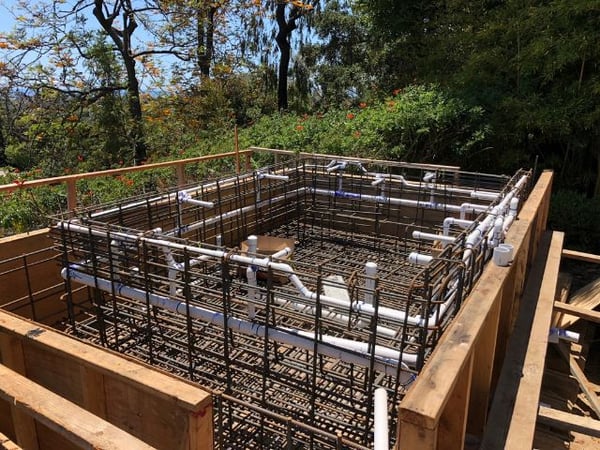Do You Need a Soils Report Before Pool Construction in LA?
The Hidden Soil Risks That Can Destroy Your Pool and Budget Why a Proper Soils Exploration Is Critical Before Building a Pool: A homeowner’s guide to...
4 min read
Vanessa Petros
:
Jun 30, 2023

“Well, that escalated quickly,” said everyone but your pool contractor.
Many things can be elevated quickly with few associated costs: sliced pineapple with a dash of tajin, a movie with the theater all to yourself, and Nickleback song with the press of the mute button.
Elevating a spa and bond beam on your property takes more time and effort.
Imagine you're a pool owner in the canyon area of Laguna Beach. As the long-awaited Summer festivities approach, you begin envisioning late nights with friends in a spa that complements the rustic beauty of your surroundings. You then think up a timeline for the spa to be complete before The Sawdust Festival’s opening day.
You schedule the pool renovation consultation while daydreaming about sipping chilled white wine with friends in your elevated spa after perusing local art. Then, poetic irony strikes with the dreaded news from your contractor: the rolling canyons you adore also create costly hurdles in raising a spa in your pool. To ensure the safety of your elevated spa, meticulous planning and a longer construction timeline are required to navigate the intricacies of your hillside home.
Siri, play “Cruel Summer” by Taylor Swift.
At J Designs Pool and Spa, we have over 15 years of experience in concrete pool construction and renovation. We’ve raised many bond beams and spas and are well-versed on the underlying costs that raise the stakes and, subsequently, the price.
This article is going to heighten three costs of raising a spa and bond beam so that you don’t have to downgrade your summer plans.
WHAT IS A BOND BEAM?
A bond beam is the elevated continuous extension of the pool shell above ground. This sturdy horizontal layer provides extra strength at the top of the pool (where the pool is weakest). It's akin to the rim of a bowl, helping to keep the top of the pool structure stable.
When the bond beam is raised higher than the deck level, it's called a raised bond beam. This is handy for dealing with stability on uneven slopes on your property without building another wall.

It adds depth and dynamic contrast to your pool area, making it more interesting. Raised bond beams can even have picturesque features like waterfalls towering over them. They're usually covered with a polished layer of tiles or stone as surfacing.
When you're planning to raise a spa or bond beam, you will need to employ specialized engineers to ensure the highest standard of stability in the elevated structure. Involving these other trades does, however, impact the overall cost.

As a rule, everything raised must still meet safety standards. This metric helps accommodate the materials used and ensures sturdy construction. To get the exact elevation measurements and stability precise, it's imperative to consult with a structural engineer. It’s an industry best practice to involve a soil engineer; they have expertise in assessing the soil composition and can identify any potentially harmful substances, like sulfates. This knowledge is crucial for the structural engineer to know in their calculations and to prevent stability issues down the road.
The structural engineer must calculate the pool's ability to handle pressure, usually around 60-80 pounds per square inch (PSI). Essentially, every inch of the pool needs to support this amount of pressure. When you think about all the inches around the pool, it adds up to quite a weighty load. That's why structural engineers are vital—they help design raised bond beams and other supporting structures to keep everything firmly in place.
However, suppose you have a slightly sloped backyard, or you're only raising a spa on a flat surface. In that case, you may only need the expertise of a geotechnical engineer. They are equipped to conduct precise calculations, taking into account various soil conditions such as moisture content and rock type. By leveraging their knowledge and skills, their expertise ensures the construction of a strong and stable foundation that adheres to the strict construction guidelines set by the International Code Council (ICC).
When assessing the costs of raising a spa and bond beam, it's important to consider these factors, including the additional labor involved with specialized engineers. By collaborating with qualified professionals, you can ensure a strong construction that will last while effectively managing the lesser-known associated expenses.
The top edge of a pool is its vulnerable point, needing extra strength and support. This is where the bond beam comes in like a shield, reinforcing and strengthening the top of the pool with necessary stabilizing materials like steel and concrete.

Think of a plastic water bottle: pushing the bottom of the bottle upward is nearly impossible due to its high amount of reinforced plastic. However, squeezing the top is effortless because it lacks strength and has a larger diameter. Similarly, the top edge of the pool is the most susceptible area and needs extra support.
The top of the pool, which bears the brunt of the stress, is fortified with additional and cost-impacting materials like steel.
The result? A bond beam thick and robust to protect the structure preventing any potential issues that could arise from the weight and pressure of the water.
In scenarios where the pool is raised above the ground, adding more reinforcing materials becomes even more critical.
As a part of the pool is elevated, it lacks the support of surrounding soil. To compensate for this, the bond beam must be wider and stronger, with additional steel reinforcement, to withstand the increased strain and maintain the structural integrity of the pool.
The higher the elevation, the more materials will be needed for the scope of the project.
Choosing and applying the right surfacing materials is vital for preventing water leaks and protecting the elevated structure. Neglecting this step can lead to issues like efflorescence or calcium buildup and cause damage over time.
To enhance the appearance of the raised bond beam or spa, you can finish it with materials like tile, stack stone, porcelains, natural stone, or other decorative options. You might also consider adding steps, fire bowls, or water features, which can add to the overall cost.

Now that you've read this article, you have a better grasp of the costs associated with raising a spa and bond beam.
By being privy to these considerations, you can plan accordingly and ensure that your ethereal poolside plans stay on track.
Although planning and costly nuances come with the (elevated) territory, J Designs Pool and Spa has 15 years of experience in navigating these sometimes rough waters. We're dedicated to uplifting your spa and bond beam visions to enhance your private oasis to the high Heavens.
The first step to your “all the way up” era is taking the leap and contacting us to schedule a consultation!
Still waiting to jump into a conversation with a pool professional? We won’t leave you suspended in mid-air or uncertainty; check out these related articles to stay tethered to more information:
HOW MUCH DOES AN INGROUND CONCRETE POOL COST? PRICING BREAKDOWN 2023

The Hidden Soil Risks That Can Destroy Your Pool and Budget Why a Proper Soils Exploration Is Critical Before Building a Pool: A homeowner’s guide to...

Why Pool Coping Fails - How to Avoid Expensive Repairs If you’re planning a new pool or renovating an older one, it’s completely normal to feel...

Have you ever wondered why your pool company talks about “certified technicians”? Or why does Los Angeles County require strict training and testing...